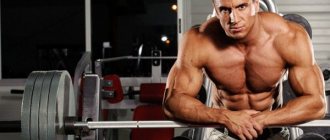The number of workouts per week is calculated individually for each person. It depends on a person’s physical activity, his workload, the goals he pursues, and of course, his state of health. The article will outline recommendations for a healthy person with an average workload.
The optimal frequency of training is most often determined by the main purpose of visiting the gym. It is this factor that affects how many days our body needs to recover. Let's see how many times it's better to train per week. Training frequency is determined by the number of workouts of a given muscle group or lifts per unit of time.
We recommend reading: How to avoid gaining excess weight during the holidays
How many times a week should men exercise?
One of the best training options for men is a split program. It consists of breaking the entire training plan into parts with the goal of working one or two muscle groups in one workout. This allows you to concentrate your strength on specific parts of the body.
If you train according to a split program, 3-4 strength training sessions per week will be enough for you, otherwise the muscles will not have time to recover and your workouts will not bring the desired results. Depending on your goals, you can add 1-2 cardio workouts or leave only strength training. The article Basic rules of split training will help you learn more about the features of split training.
If you are training in a full body program (this is a full body workout that is most often used by beginners, but also found in advanced athletes), then they should be done much less frequently, otherwise you will put your body into a state of overtraining. If you are working on gaining muscle, you should only consider a split training system.
Three approaches to training frequency
Set 1 - only 3 workouts per week (1+1+1)
Train three times a week. This school is suitable for you if you are a beginner or are training to maintain your tone. By working out 3 times on different muscle groups once each, your muscles will have time to rest, and you will be happy to go to workouts. If you are a professional athlete or want to lose weight quickly, then this school is not for you.
Approach 2 - short training up to 6 times a week (2+2+2)
If you want progress, exercise 6 times a week. Beginners should not train using this system, as this can lead to overtraining, as well as unwanted injuries. You won't get good results and will most likely stop training. Again, some successful athletes and Bulgarian lifters supported this approach.
If you still choose this school, then you should not train for more than an hour. You will tire your body and your muscles will not have time to recover. Your training will not bring the desired result. And here are tips on this topic from Ekaterina Usmanova for girls to train their buttocks.
Ekaterina says that, unlike men, girls have problem areas in the hips and buttocks. Therefore, men's and women's glute workouts will be very different. Men just need to do the base to increase volume, but girls need to do the shape.
Most girls have a pear-shaped body and it is much more difficult to work out the bottom. Usmanova suggests training your buttocks 3 times a week. One workout will include a core workout (e.g., squats, lunges, deadlifts), and the other 2 workouts will focus on butt shaping and include isolation exercises.
The exercises in these workouts should be constantly varied. These can be the same squats, only without weights and for a large number of repetitions; simply the placement of the legs, abduction, extension of the legs in the simulator, and so on can change.
You can also follow the standard path: train for weight, include 1 basic workout per week in the training process, and then, during drying, add more isolation exercises to the program that will draw the shape of your buttocks.
Approach 3 - based on how you feel at the moment of maximum Supercompensation
Train hard and repeat training on this muscle group when you feel a surge of strength. In other words, we are talking about Supercompensation - the post-training period during which the trained function has a higher rate compared to the initial level.
Every workout involves breakdown of muscle fibers, depletion of key nutrients, and, of course, fatigue. This leads to a decrease in functionality. From this starting point, your body will recover by increasing muscle protein synthesis to rebuild muscle tissue, bringing you back to baseline as quickly as possible. If recovery is normal, a period of supercompensation occurs, during which your functionality exceeds your baseline level. This means that your muscles are growing faster than before.
Thus, for one muscle group you do the following approach starting (approximately!) from the third day to the tenth. This method has been followed by some of the most successful bench press athletes of all time.
How many times per week to train for weight?
If you want to build muscle mass, the emphasis should be on strength training. They should devote 3-4 days a week. The main rule is not to train the same muscle group several days in a row. Use splits. This is a training program method that involves performing exercises on different muscle groups on different days.
Example of a weekly plan:
- Monday Upper Body Exercises
- Lower body exercises on Tuesday
- Recovery Day (Wednesday)
- Repeat the same division on Thursday and Friday
Each muscle group - 2 times a week
This brings us to the golden mean, ideal for most amateurs - training each group, on average, twice a week or once every five days. This allows you to create the required training volume and maintain high intensity, as well as have time to recover.
The most popular division of muscles is “top” and “bottom”. But there are other options.
We recommend reading: Close-grip dumbbell press
If you are not gaining muscle as quickly as you would like, you may be experiencing a plateau effect. To put it simply, this is a “period of stagnation.” When the same muscles are trained over a long period of time, identical exercises are performed with the same weight, there is a high chance that the body and metabolism will adapt. Also, the reason for the lack of results can be overtraining, genetics, incorrect and ineffective exercise technique.
To get back to the muscle building phase, you need to change something. Several ways to fix the situation:
- Increase the weight in your workouts
- Add new exercises to your routine
- Change the number of sets and reps you perform
Choose suitable exercises and organize them
So, you already know your goals and have an idea of the structure of your workout. Now we will talk about dividing exercises into categories , and we will focus separately on the muscles of the body. This form of training design will help you focus on different parts of the body in always different ways. Make categories that have a reproductive system. Every training plan should address exercises for the entire body area , and these are exercises for [6]:
- Upper Body Pressure Focus – These are exercises that focus on the upper half of the body, specifically movements that involve pressing weights away from the body or the body away from objects. These include push-ups, bench press and dumbbell press.
- Upper Body Movement Focus – This refers to a workout that works the muscles of the upper body, such as rowing, or pulling objects towards the body, or pulling the body towards objects. These include, for example, exercises on the horizontal bar, all types of exercises with dumbbells and rock climbing.
- Quadriceps major – movements that engage the anterior thighs, sciatic muscles, and hamstrings. For example, squats and lunges, bench lunges, step board exercises and high jumps.
- Hip stretches are exercises that work your hips, lower back, sciatic muscles, and hamstrings. Here we include the deadlift and all its variations, a type of bridge called a hip thrust, long jump or sprint.
If you do not divide your workouts into muscle groups, but always train the whole body , you should add the exercises mentioned above to each workout. In addition, it is also necessary to train small muscles , and at least once a week. Specifically, we mean [6]:
- Core – exercises for the center of the body, thanks to which you will strengthen the abdominal muscles, specifically the rectus abdominis and oblique muscles. This includes exercises such as planks, leg slides and squats.
- Grip – Exercises that will strengthen your arms and forearms, such as farmer walks, dumbbell wrist curls, or resistance band squeezes.
- Shoulders – Exercises to strengthen rotation in the shoulder joint and upper spine. For example, traction of the middle block or stretching of the expander in width.
- Thigh Muscles - Weak quads can lead to injury and painful pain, so you shouldn't miss them in your training plan. Try exercises like side lunges, resistance-band walking, or side leg raises.
What to do on recovery days?
The recovery period does not mean total laziness and lying on the couch. Light training is recommended on these days. This could be stretching or some light cardio (brisk walking, cycling).
Regular stretching can increase blood circulation. This ensures sufficient blood flow to the muscles, which helps reduce recovery time and reduces muscle soreness after intense exercise.
It has been proven that after complete recovery, a period of supercompensation begins, during which functional capabilities exceed the initial level. During this period, muscles grow faster.
You should also pay due attention to sleep. During the deep sleep phase, the hormone somatotropin is released, due to which muscle tissue is restored faster, and the level of the stress hormone cortisol, on the contrary, decreases. Without proper rest, the next workout can become counterproductive, as problems with concentration and performance inevitably arise as the nervous system is depleted.
Individual stress, serious physical or mental stress at work, and a poor diet can also lead to under-recovery.
Discussion
First of all, I would like to start by saying that I feel much better when analyzing strength data than hypertrophy data. The strength measures are usually nice and clean, and the changes are usually pretty obvious. For 1-time max tests or torque measurements, there is no significant measurement error, and the strength gains are usually large enough that you can be confident that you are seeing real changes. Additionally, poor adherence to pretest guidelines will generally not be a very poor strength test. It doesn't matter if someone accidentally drank caffeine before testing or forgot to report to the fasting lab station (you're trying to control for those things, of course, but sometimes people lie; but when measuring strength, things like that just don't make much of a difference).
With hypertrophy, on the other hand, the changes tend to be much less pronounced (for example, weekly strength gains in my previous analysis were about 4 times greater than weekly hypertrophy in this analysis, although both analyzes used basically the same set research), and sometimes do not even exceed the measurement error of the device you are using for testing. Poor adherence to pretesting guidelines can also make a huge difference, especially for indirect measures of hypertrophy (there's a great article by James Krieger on how to manipulate DEXA results). Also worth noting are the hardware issues; if you have a good ultrasound machine that shows you really clear boundaries of the fascia, measuring the thickness of the muscles - then everything is simple. If you have an older ultrasound machine, there is a reasonable amount of guesswork involved.
I say all this just to point out that I have a little less confidence in these results than I do in the strength studies, simply because I have a little less confidence in the hypertrophy data in general. Collecting good force data is fairly simple; collecting good hypertrophy data requires more trust in your participants and your equipment when you're already trying to find smaller absolute changes or differences.
In broad strokes, higher training frequencies seem to have a greater effect for untrained athletes than for trained ones and for low training volumes than for high ones, and when you assess hypertrophy using indirect measures (i.e. lean body mass), than direct measurements (ie muscle thickness). Most of the differences were still significant in favor of higher frequencies, but the relative advantage of higher frequencies seems smaller if you are an experienced athlete (32% vs. 47% for untrained), if you have high training volumes (27% vs. 77% for light training sessions). volume), and if you're more interested in building specific muscles than just gaining muscle mass (17% for direct measurements, vs. 49% for indirect measurements).
Moving from left to right, the lightest color indicates a minor effect size, the next lightest indicates a small effect size, then medium, and then large at the far right.
So the question becomes: why might higher frequencies be better for muscle growth?
I think the most obvious explanation would be that higher frequencies allow muscle protein synthesis (MPS) to be stimulated more times during the week. Unfortunately, most of our MPS data comes from studies looking at mixed MPS, whereas myofibrillar MPS is what we really care about. There is also a dose-response relationship between training volume per session and MPS per session (i.e., muscle protein synthesis is not just an on/off switch; if you increase volume during a session, MPS will rise and rise longer after that session) , so it is not clear that training a muscle more often with less volume per session actually causes more total MPS over the course of an entire week. Now, if these dose-response relationships were truly fleshed out, we could use this information for some theory development. For example, if we found a plateau in MPS per session after 5 sets for a given muscle, we could say with some degree of confidence that doing 5 sets four times a week would be better than 10 sets twice a week. However, we don't have that level of detail yet.
A second potential explanation could simply be higher volumes with higher frequencies. Volume during work sets was equalized in all of these studies, but higher frequency groups would complete more complete warm-up sets during the program. While warm-up sets certainly won't impact hypertrophy the same way as working sets, they still induce some level of training stress.
A third potential explanation could simply be the effort and energy that can be expressed in each set. If you know you need to do multiple sets of the same exercise, or if you need to do multiple sets in one workout, it's natural to wait a little bit first so you still have some energy left at the end of the session, or start to relax a little closer to at the end of the session when you start to feel tired (I'm sure this doesn't apply to you individually because I'm sure you're giving it your all, but that's a natural human tendency). Of course, having research assistants present to nudge subjects helps curb these tendencies, but I doubt it completely reduced the difference in given effort. In one of the studies included in this analysis, internal training load per session was ~35% lower in the higher frequency group, and total volume load ended up being 16% higher; another study had very similar results. Another study also found lower ratings of perceived exertion (using an effort-based scale rather than a reserve-repetition-based scale) in the higher frequency group. So we know that subjects found each session easier, on average, which sometimes resulted in a larger workload, so I think the higher set load likely played an important role.
Since my article on power, two questions have come up repeatedly that are worth addressing here:
1) Is it possible to train the same muscle on days when it still hurts?
2) Doesn't higher training frequencies increase the risk of injury?
Most studies examining the course of post-training recovery find that it can take 2-4 days for muscles to fully recover from a challenging workout (depending on training condition, volume, degree of eccentric stress, etc.). Most people believe that they should wait until the muscle has fully recovered before exercising it again. However, there is no conclusive evidence (that I am aware of) to support this assumption. In fact, there are three studies comparing sequential and non-sequential training (that is, training the same muscles on back-after-back days, and resting at least 48 hours between workouts for the same muscle), and none of the three found no negative effects for consistent training. All three of these studies used untrained athletes. Also, keep in mind that at higher frequencies, the volume of each session per muscle group needs to be lower, making training the same muscles back after back much more doable.
In terms of injury risk, I think there is a scientifically and practically sound answer.
A recent study of powerlifters found fairly weak associations between training frequency and injury risk (in some analyzes there was a positive association, and in some analyses, a negative association). Additionally, most acute injuries tend to occur when fatigue sets in and focus becomes dull, so I suspect that higher frequencies may reduce the risk of acute injuries by reducing the volume of exercise per session. I think the effect of frequency on chronic injury risk will be largely determined by technical skill. I don't think that with good technique, higher training frequencies will increase the risk of chronic injury. However, with poor technique, it wouldn't surprise me if higher frequencies increase the risk of chronic injury, often putting your tendons and/or ligaments under excessive stress. This is the scientific answer.
Practical answer: A lot depends on how you approach training mentally. If you like to go all out on every set and maintain a high level of volume in every session for every muscle group, thus pushing yourself to the point of exhaustion by the end of the workout, then high frequencies are probably a bad idea. If you take a more relaxed approach to training (and with good technique), you will probably be comfortable with higher frequencies.
As a final note before we wrap things up, I think the volume-consensus literature (reviewed in this article) may be underestimating the effect of frequency on hypertrophy. We know that volume appears to be the primary metric in hypertrophy, and generally increasing frequency allows for increased volume. Doing 20 sets of squats in one session will baffle most people, but doing 5 sets of squats four times a week is generally challenging but doable. I think higher frequencies may increase the risk associated with increased volume. If you only train legs once a week and you go all out in one session, at least you have a week to recover before training legs again; most people can recover from anything in a week. However, if you train legs four times a week and the volume is too high, you'll be putting yourself deeper and deeper into a hole, increasing your risk of exhaustion or overtraining. So increasing the frequency can be beneficial, but you have to be smart about it. Effective monitoring of recovery is likely to become more important with higher training frequencies.
How to avoid overtraining?
This is an equally important topic compared to how often to exercise. First of all, you need to monitor your progress. If you stop progressing in at least one exercise, this may indicate that you are close to overtraining.
In the example we considered above, this is what happened, because the builder noticed that he had stopped improving his results in the bench press. If a similar situation happened to you, then you should rest. Here are the three main symptoms of overtraining.
We recommend reading: How not to gain weight during the holidays
- The working weight in exercises does not increase. To progress, you need to gradually increase the load. However, for this, the body must fully recover so that you can work with heavy weights.
- The number of repetitions or the time of static holding of projectiles does not increase. If the working weight does not increase, then the number of repetitions or the time of static holding of the projectile should increase.
- You spend more time doing the same workout. The effectiveness of training is closely related to the concept of intensity, which is measured in units of time. Simply put, if it took you longer to do an activity you did a few days ago today, then the intensity has dropped.
Quality of exercises
When we talk about a particular number of working approaches, we a priori mean that each of them is performed with the correct technique and to failure. In the absence of these conditions, trying to give a clear answer about the required level of load volume is even more difficult. Obviously, the value of one approach performed not to failure is significantly lower than to failure. If an athlete is able to perform an exercise with a weight of 100 kg 15 times, but does only 10, then the changes occurring in the muscle cell will be clearly insufficient to stimulate the maximum possible hypertrophy. In this case, in order to accumulate the beneficial effects of the load on the muscular system, you will have to perform much more approaches than if they were extremely heavy. The less local fatigue a set causes, the more such sets should be performed. A typical example is the training of amateur girls. Women, by nature, perceive rejection differently than men. As soon as it becomes more or less difficult for them, they stop doing the exercise. Then literally a minute later they do it again, since there was no particular fatigue. For this reason, trainers can safely “prescribe” their female wards 12-16 approaches per muscle group without the risk of excessive catabolism and overtraining. Incorrect exercise technique leads to the fact that the target muscle group does not receive the proper load during one approach. In such situations, the athlete usually does not feel “pumped up” and “clogged” in the muscle that the exercise is aimed at. As an example, perform the exercise “dumbbell row to the belt in an inclined position.” A careless athlete takes too much weight and is unable to perform a deadlift using only the latissimus muscle, and begins to rotate the torso using the core muscles. The dumbbell rises higher, but the degree of participation of the latissimus muscle in the exercise is not great; failure occurs, but not due to its fatigue. Accordingly, the value of such approaches is not great. Therefore, you have to repeat them until the muscles receive the necessary fatigue. Technical errors are different, but sometimes they are caused not by the technique of the exercise, but by the anatomical characteristics of the athlete. That is, an exercise that suits the majority is not suitable for a particular athlete. With a height of two meters, it is very difficult to perform squats in a more or less acceptable amplitude without transferring the load from the legs to the back. Tall athletes, when squatting with a barbell, often simply “fold” and their back is the first to fail, not their hips. Therefore, two or three such sets of squats do not stimulate the growth of the thigh muscles. The greatest number of technical errors or inappropriate exercises can be found among complex, multi-joint movements with free weights. It is more difficult to make mistakes with machines or single-joint exercises. Lyle MacDonald's words "If you can't get a muscle group to grow from 4-8 heavy sets, it's time to stop training like a weakling" in relation to this situation could be supplemented with the following: "...it's time to stop training like a weakling, with incorrect technique in exercises that are not suitable for you."
Recommendations for training for muscle growth
If you have planned your training process correctly, then the question of how often to do training will not arise. The fact is that training at any frequency can be effective if you use the right volume. For high-quality muscle pumping, the ideal weekly volume of work for each muscle group for most athletes is 12 sets. Of course, this is an average value and you should determine the effective volume for yourself individually. Now it is important that you understand the very essence.
- If you train each muscle group only once a week, then you need to do all 12 sets, since the frequency of training is low, you will have to use the entire volume at once.
- When training each muscle group three times a day, you should perform 4 sets in each session, which will result in a weekly training volume of 12 sets.
- If you have two workouts a day, then each muscle group in one lesson should be pumped in six sets.
Note that 12 sets per week is sufficient volume for large muscle groups. For small ones, half of this volume will be quite enough.
When talking about how often to train, it is necessary to take into account the athlete’s training experience. For beginner athletes who have been training for less than eight months, a three-day split is ideal.
If you have passed this stage and have been training for more than eight months, then you should switch to twice a day training sessions during the week. We recommend that in this situation you divide the body into upper and lower halves.
Many people do not have enough time to visit the gym at least twice during the week. As a result, they have to be content with one training session. If you do everything correctly, then this strategy will be effective, but definitely not the best. To a greater extent, this frequency of exercise is suitable for maintaining muscle tone. If you want to progress faster, try to find time for two workouts per week.
Calculate your ideal sports weight!
Training frequency and number of sets
The more often we train the same muscle group, the fewer approaches we should perform at a time. This recommendation is found quite often, moreover, it forms the basis of training the whole body at one time - “fulbadi”, two-day split, the HIT system and Dogcrapp. Why do 99% of those who train do not one, not two or three approaches per muscle group, but more? Because it brings results. As sports science says, the greater the load on muscle fibers, the more growth factors are formed in them, the more anabolic hormones penetrate into them. For those unaware, at rest, up to 90% of all testosterone circulating in the blood is unable to penetrate muscle fibers, but the opposite is true under optimal physical activity. We literally pump testosterone into muscle cells, performing set after set (although for “natural” athletes this is not as important as for “chemists”, since “natural” athletes have very low testosterone levels and its fluctuations in response to load are not significant - limit 10-30%). Once inside, the latter begins to actively stimulate protein synthesis, which leads to its utilization. The only thing that stops us from repeating high-volume training every day is that doing many sets will not only pump a lot of hormones into the muscles, but also cause a high accumulation of hydrogen ions in them. Hydrogen ions are not only a growth factor, but also a powerful catabolic factor. If you do not wait until the muscle has more or less recovered and subject it again to a similar load, then the catabolism caused by hydrogen ions will cancel out the results of the previous load, as it will destroy the resulting protein structures that have not formed into full-fledged myofibrils. Catabolism must be dosed both in magnitude and frequency. And here the logic of high-frequency training of one muscle group with a small volume of load on it begins to emerge. More frequent training more often releases anabolic hormones into the muscles and more often stimulates protein synthesis due to local growth factors and activation of signaling systems. At the same time, a small volume of load, although it will not “let in” many hormones into the muscle cell and does not stimulate protein synthesis to the maximum extent, will not cause pronounced catabolism. So what is better in practice: do a lot of sets on a muscle and let it rest for 7 days, or do several sets, but two or three times a week? There is probably no point in blindly listening to the opinions of athletes, coaches and methodologists, since each of them will defend their usual training scheme. However, there is a clear trend in recommendations that are addressed to athletes who do not use anabolic steroids. Most reputable experts insist that a “natural” should train more than once a week and the volume of training should be limited! Thus, the most famous nutritionist in the world of sports, Lyle MacDonald, says the following:
“You need to train a muscle group at least twice a week. A top-bottom split of Monday, Tuesday, Thursday and Friday will be optimal for most. Full body workouts twice a week are also good. Leave training each muscle group once a week to the genetic elite or those who use steroids. When in doubt, always reduce the volume, but do not increase it. Despite magazine articles, you don't need a million sets for hypertrophy. If you can't get a muscle group to grow from 4-8 heavy sets, it's time to stop training like a weakling."
Similar recommendations regarding the frequency of training are given by the previously mentioned Lane Norton, a famous trainer, bodybuilder, powerlifter and scientist who promotes natural training:
“It has already been scientifically proven that the paramount importance is not single, but repeated training of each part of the body throughout the week. I've found this to be true...Training each body part once a week can be effective for beginners, but I believe that over time, training twice a week will increase muscle strength and size much more."
American sports scientist Michael Thomas, in the process of writing his doctoral dissertation entitled “Increasing muscle mass and strength: a comparison of high and low frequency strength training,” conducted studies involving seven women and twelve men with at least several years of training experience. He divided the study participants into two groups. One group performed a traditional weekly split, in which muscle groups were distributed by day of the week as follows: chest + shoulders + triceps (Monday), back + biceps (Wednesday), legs + calves (Friday). During the workout, participants performed 9 sets for each muscle group of 8–12 repetitions. The second group trained all of the listed muscle groups per workout, but did 3 sets of 8-12 repetitions. There were three such training sessions per week: on Monday, Wednesday and Friday. After 8 months, Michael Thomas measured gains in muscle mass and strength in both groups. Participants in both groups showed progress, but there were no statistically significant differences. Both of them progressed equally. That is, the pattern of frequent training with a limited volume was effective, but no more effective than a traditional split training one muscle group once a week. What if the participants trained as MacDonald recommends, 2 times a week for 4-8 sets? Unfortunately, there are no such studies, but it is worth listening to the opinion and experience of this sports physiologist. At least what he says is logical. Limited volume of load on a muscle group with a higher frequency of training. Only your personal practice will show how effective this is.
How often to train for relief[edit | edit code]
The number of muscle fibers with restored functional integrity after injury.
The assessment was carried out by recording action potentials in individual fibers after stimulation of the muscle on the uninjured side. C—control (undamaged) muscle. Open circles are averages (Stuart, McComas, Goldspink and Elder. 1981) The main parameter that is subject to dramatic change during this period of time is the caloric content of the daily diet. If you are faced with the task of getting rid of excess subcutaneous fat, then your daily energy expenditure should exceed what you get from food. How big the difference will be depends on the timing of preparation for the competition.
The usual training period for an average level athlete is 2-3 months. Although there are those who can easily get themselves into competitive shape in 1-2 weeks. But this is an extreme case and is hardly worth taking seriously. Usually, at the very beginning of the preparation period, restriction of carbohydrates in the diet begins; as a rule, for a certain period of time, the athlete resorts to a carbohydrate-free diet. How long should a “no-carbohydrate” diet last, is it worth resorting to carbohydrate alternation, etc. - questions that are beyond the scope of this article. We will remember for now: the main difference between the period of working on the relief is limiting the caloric content of the diet. However, one of the interesting preparation options is the following: the athlete loses weight as much as possible, and the period of preparation for competitions coincides with the period of gaining muscle volume. It is clear that in this case there will be no talk about any restriction of calorie intake (only carbohydrate alternation is possible in the later stages of training), in general, the task comes down to the “typical” one, that is, working on muscle volumes. Kevin Levrone usually prepared according to this scheme, Gunther Schlierkamp used it in the last years of his performances, and Dexter Jackson often used this scheme. The main advantages of this scheme: Catabolic processes are minimized (aerobic exercise is practically eliminated), there is no threat of loss of muscle mass.
From the very beginning of preparation, you can see which muscle groups need to be “tightened” and what should be worked on first. But let's return to the typical “drying”. As for training during this period, it is very difficult to give clear recommendations. The key is to avoid falling into a catabolic hole, which means you shouldn't exercise too often. For some, training with heavy weights is most suitable, for others, they rely more on the volume of the training process, for others... One of the possible options for constructing the training process is given in the article by Yuri Spasokukotsky “Training while working on the relief” in the same issue our magazine. Here I just want to mention two features of training during the “drying” period: It is mandatory to include in the training process either aerobic exercise, or interval training, or aerobic strength training (the latter, in my opinion, is most preferable). It is likely that special attention will have to be paid to 1-2 lagging muscle groups, the lag of which will become more and more obvious as you get rid of the subcutaneous fat layer.
PHARMACOLOGICAL DRUGS.
During this period, everything is used that can have one or another effect on fat burning - be it by “spinning up” metabolism (triiodothyronine, DNP), increasing thermogenesis (caffeine, ephedrine), enhancing the release of fatty acids from fat “depots” (metformin) or switching the body to use fat as the main source of energy (clenbuterol). In principle, fat burners from the world of sports nutrition will do the trick at first, but pharmacological drugs are much more reliable and effective. If we talk about hormonal drugs, their selection is very sophisticated. As a rule, those that may contribute to water retention are excluded from consideration. Although, with reasonable use, good results can be obtained even with a drug such as Sustanon-250, despite the fact that it will be almost the only AAS on the “course”. During the preparation period for competitions, the use of growth hormone is mandatory - mainly due to its anti-catabolic and powerful fat burner properties. However, recently, your humble servant has become more and more inclined to believe that the use of IGF-1 is more preferable. Moreover, participation in the “process” of growth hormone becomes completely optional. Thus, insulin-like growth factor will allow, to some extent, in the 2-3 week period before the start, to imitate the work of DNF, while allowing you to train hard. IGF-1 is an excellent fat burner; its daily use for 10-12 days will allow you to “squeeze” glycogen out of the muscles as much as possible; stopping taking this drug will mean the beginning of a gradual filling of the “depot” with glycogen (the filling process, as practice shows, reaches its maximum on 7-8 days after discontinuation of IGF -1).
Frequency of strength training[edit | edit code]
Source: "Training Programs"
, scientific ed.
Author:
Prof. Dr. Tudor Bompa, 2021
The length and frequency of rest breaks between strength training sessions depends on the athlete's fitness and recovery ability, the stage of training, and the energy source used during training. Well-trained athletes always recover faster, especially as the training program approaches the competition phase when the athlete reaches peak fitness. Typically, strength training follows a technical session, and if athletes are using the same body energy system and energy source (eg glycogen) during technical and strength training, the next training session of that type should be scheduled two days later to ensure that glycogen stores are fully replenished. 48 hours are required[1][2]. Even if an athlete's diet is rich in carbohydrates, glycogen levels do not return to normal in less than two days.
If athletes perform only strength training, as sometimes happens during the preparatory phase, glycogen replenishment occurs faster: 55 percent in 5 hours and almost 100 percent in 24 hours. Accelerated recovery of glycogen stores means that the frequency of strength training can be increased. When performing a strength training session in which multiple sets of low repetitions without working to failure are followed by appropriate rest breaks, the athlete should not have to worry about glycogen replenishment since the body's primary operating system will be the anaerobic alactic ATP-CP system.
When planning strength training sessions, you should also consider the time required for muscle protein levels to recover. Untrained athletes who perform a resistance training program that includes a combination of concentric and eccentric activities experience muscle fiber breakdown (protein breakdown) that continues for 48 hours after the completion of resistance training[3]. The good news is that the rate of concomitant net increase in muscle protein synthesis exceeds the rate of breakdown. Further increases in protein synthesis or muscle fiber repair after strength training can be achieved by consuming a carbohydrate-protein mixture immediately after the training session. In trained athletes, muscle protein recovery usually occurs faster.
Finally, perhaps the most important factor to consider when planning strength training is nervous system fatigue. When performing high-intensity workouts one after another, there is not enough time for nervous recovery. For example, many athletes perform maximal strength training on Monday and have a plyometric workout scheduled for Tuesday. Because the same nerve pathways are recruited during both training sessions, the athlete does not have enough time between the two workouts to recover, and unless a limited amount of work is performed during both sessions, the athlete may become injured or exhibit symptoms of overtraining.
In general, the authors of the vast majority of scientific studies argue that the duration of recovery after a strength or aerobic training session should be appropriate to ensure that all body systems have sufficient time to regenerate and adapt to training impacts before moving on to a similar load or more aggressive training session of the same type. In the training cycle, recovery plays just as vital a role as the training stimulus applied. Specifically, energy reserves must be replenished, the nervous system must be restored, and a positive protein balance (synthesis minus breakdown) must be maintained in order for gradual increases in muscle strength, power, endurance, or muscle size to occur.
This process can be simplified by developing training programs in accordance with the body's energy systems involved. Chapter 3 discusses in detail the role of the body's energy systems in training, and also outlines the amount of time required for an athlete to recover after a training session.
Periodization of training[edit | edit code]
The principle of planning the frequency of training
The frequency of training in bodybuilding is categorically different from periodization in any other sport. Because, firstly, at different stages the athlete is given two directly opposite tasks: to gain weight and to lose weight. They can be combined into one cycle, but it is better to separate them. In addition, preparing for competitions is not just banal weight loss, it is an attempt to reduce the amount of fat and water in the body to an absolute minimum. In this case, it is necessary to achieve uniform development of muscle groups, “correct” (by available methods) proportions, etc. and so on. The training parameter in bodybuilding is muscle volume. Strength is not taken into account; it is viewed rather as a “by-product” of mass training. The increase in muscle volume itself can proceed along two main paths: hyperplasia (increase in the number) of muscle fibers and hypertrophy (growth in their cross-section). Here it should be taken into account that there are at least two different types of fibers; in general, training should be built on the assumption that there are three of these types. The tasks are non-trivial, it will not be possible to combine them even with all the great desire, which means that we need to approach their solution consistently. It is this sequence of solving diverse problems that constitutes the essence of periodization in bodybuilding. Moreover, not only the fact of how often you train, but also diet and pharmacological preparation have its own characteristics.
If we talk about diet during this period of time, then the calorie content of the diet should exceed your energy expenditure. This is the only thing that unites the mesocycles of work on hyperplasia and hypertrophy. It is from this that it becomes clear how often you need to train.
Hyperplasia[edit | edit code]
The main feature of this period is the use of such a pharmacological drug as insulin-like growth factor. That’s right - we adjust everything else to this drug. Duration - 4-6 weeks. It is this duration of this period that, in my opinion, is optimal. This is explained by two factors: After 6 weeks of use, the effectiveness of any training program decreases sharply. The optimal duration of use of IGF-1 is exactly 6-7 weeks.
Training at this time is a “rabid” “pumping”. However, only 3 sessions per week can be devoted to this type of training - on the days of IGF-1 injections. You can “get” another 1-2 sessions, say, through plyometrics or “explosive” repetitions (see below). An important feature of “pumping” is that it will significantly increase muscle density. That is, the period of working on hyperplasia will also be a period of working on muscle density.
Of the pharmacological drugs, in addition to IfR-1, it is worth leaving in your arsenal only testosterone, to which you can add (or not add) nandrolone or anadrol or methandrostenolone. It must be said that some of the testosterone injections should be carried out not into the gluteal muscle, but into the group that was subjected to training the day before or will be training soon (if these are the arms, then injections can be done into the deltoid muscle, legs - the outer part of the quadriceps; do injections into the muscles of the back or chest are not necessary - systemic ones can be used).
Hypertrophy[edit | edit code]
This period should ideally immediately follow the period of hyperplasia. Its duration is the same as the period of work on hyperplasia, that is, 4-6 weeks. Here, significant changes are made to the training process, and the pharmacological drugs used also change.
In fact, we move on to strength work, that is, we try to use the maximum weights with which we can handle 5-8 repetitions per set. The duration of rest between sets is slightly increased, methods of intensifying the training process such as supersets (trisets and giant sets even more so), drop sets and others like them are completely excluded. As for “pharma,” as you probably already guessed, IGF-1 is not used during this period. As for me, it would be justified to introduce insulin and dexamethasone into your “diet”; from AAS, the main bet should be on the same testosterone, adding trenbolone and oralturinabol to it (this is if the latter now existed in nature).
Volume training[edit | edit code]
I do not consider it necessary to allocate my mesocycle for this type of training, but for fans of “volume” it is quite possible to do it after working on hypertrophy and just before returning to the “hyperplastic” mesocycle. What are the goals of volume training? All the same - growth in the cross section of the muscles. But it will happen mainly due to an increase in the amount of sarcoplasm. Okay, I agree, this is also important, so a volumetric mesocycle can be planned.
If you decide to train for volume, then the optimal cycle duration is 3-4 weeks. I will not present the principles of this training system here; we have written about them more than once. For the uninitiated, volume work is work in which one exercise is performed per muscle group - in 10 sets of 10 repetitions each. You can do one additional exercise (3 sets of 10 repetitions). During a workout, two muscle groups are “pumped up”.
In fact, volume training is a rest, first of all, for the nervous system - nevertheless, the central nervous system is subjected to significant stress while working on hypertrophy. And we really need such a rest, even if we ignore the other “charms” of the “volume” (well, I agree: another argument in favor).
The arsenal of pharmacological agents during volume training is almost the same as in the previous case.
Working on different types of muscle fibers[edit | edit code]
It is hardly worth dedicating a separate mesocycle and even microcycle to working on types of muscle fibers that are not your main ones. It would be more logical to integrate such training into your regular microcycle. For example, you can plan to train slow fibers during the mesocycle dedicated to hyperplasia. Fast-twitch muscle fibers need to be trained during the “hypertrophic” mesocycle, although it would be better to devote 1-2 days to plyometrics or “explosive” training during the period when new fibers of this type will be formed, that is, in the “hyperplastic” mesocycle.
Important points to remember
Arnie, one of the most outstanding bodybuilders in the world, never missed an opportunity to train, and devoted absolutely every free minute to training. Of course, to reach such a high level, he went through quite a long journey, which allowed him to train up to several times a day. It is certainly possible to follow in the footsteps of the famous bodybuilder, but do not forget that Arnie did not immediately become strong.
As a newbie, he went to the gym no more than two or three times a week. Once his body got used to the stress, he increased the number of training days. Any other experienced athlete can do the same, but only when the muscles do not ache or ache. In addition, one should take into account the fact that victories in competitions, fame and money became an excellent incentive for him to maintain his shape.
In the world of professional bodybuilding, competition is quite fierce and every athlete strives to become better. This was the main reason that Arnie had to completely revise his training plan, increasing the intensity and frequency of training. Some bodybuilders take steroids with proteins, which allow them to speed up recovery processes and also quickly adapt to increasing loads.
The key to the success of successful bodybuilders is that they are completely able to concentrate on the training process and not be distracted. They can push themselves to the point of exhaustion even when lifting light weights because they have a clear idea of the result they want to achieve.
Another important point that absolutely all beginners should take into account is that without rest days they train inconsistently, but only three or four weeks before the competition.










